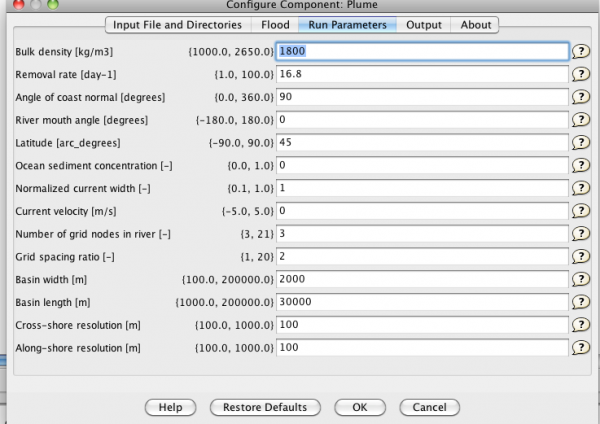Labs PLUME
Plume Modeling
Once we have moved sediment and water over hillslopes and routed it through a river system, we can think about this flux of water and sediment draining into lakes or into the ocean. Typically the riverine freshwater and the suspended sediments will form a so-called hypopycnal sediment plume. We will use a component called PLUME to investigate the behavior of these sediment plumes. The model is largely based on turbulent jet theory presented by Albertson et al., (1950). In this lab we will look at the river plume characteristics and the depositional patterns for single plume events.
To learn more about Plume and its approach you can download this presentation.
STEP1 Load the PLUME component
If you have never used CMT, learn how to use it here.
>> Open the CMT, Go to Projects, Courses, choose 2013.
>> Drag the PLUME component into the driver palette.
>> Specify a unique working directory for each experiment, for example: /CMT_Output/PLUME1
>> (…etc PLUME2 for the next experiment).
River Characteristics
In this lab we will focus on a specific braided river system in West-Greenland. The Watson River drains a small section of the Greenland Ice Sheet, it winds through a narrow braided river plain for about 20km and then drains into Kangerlussuaq Fjord. The photo shows the river braidplain in 2012, which was a peak discharge year in Greenland The waterdepths on the braidplain are typically not very deep (>1m with perhaps a smaller channel section that is deeper ~ 3m).
Question 1 Use the annual hydrograph of the Watson River to estimate discharge events for 2 days in the summer. Indicate what your choosen dates and discharges are. The photo above will help to estimate a river mouth width. Can you estimate the river flow velocity? Please motivate your answer.
>> Set up two simulations of plume model for the different discharge events you have estimated.
>> Keep each run at 10 days total simulation time, with each discharge event to last for 2 days and ask for an output grid for every 2 days.
>> Change the default basin geometry to be 4 km wide and 60km long to match the fjord dimensions of our case-study.
>> Make sure you switch the output file ON!
>> You can use the ‘flood’ tab in the plume model to configure your simulations for the selected river input parameters.
>> Download the generated depositional grid for visualization in VisIT: ‘model_grain_class_0__deposition_rate.nc’
Question 2 How far out did sediment get deposited by the plume during early season conditions and how far out at high melt season conditions? How thick was the thickest deposit for each of the two events? Plot your two output grids.
Sediment Settling Rates
PLUME is one of the key components of the marine sedimentation model SedFlux; river plumes are just one of the marine processes that control marine sedimentation. Other processes include waves and tides and turbidity currents and biological production. The stand-alone plume component runs for a single flood event, and it runs for a single suspended sediment load class only. You can imagine that in a more comprehensive framework the plume model runs for several grain-size classes and for a sequence of many different discharge events over time. We will look at the effect of changing the suspended grain-size in the river.
Empirically, sediment removal rates, λ, [1/T] for fine sediment in the plume model are defined as a function of grain-size, D:
λ(D) = 0.222D_+ 1.573
This relationship was derived from time-lapse image analysis of underwater particle settling for grains between 2 micron and 42 micron.

>> Run 3 simulations of PLUME. Vary the removal rates systematically.
>> List your discharge scenario and basin shape.
Question 3 How much effect does the removal rate have on the overall plume depositional pattern? Plot the 3 final grids of sediment deposition using Visit (use a log-scale to better show the differences).
Question 4 Compare the empirically derived removal rates with Stokes settling velocities for these grain diameters? What would be the removal rates if you assume turbulent conditions during settling? Can you explain the difference?
Plumes in an ocean basin
In most real-world cases plumes will enter an ocean basin where other conditions affect plume behavior. One of these effects is the importance of longshore currents. The following experiments show the effect of a persistent longshore current acting on the plume. The plume model can calculate the effect of Coriolis force when small longshore currents act upon the plume
.
>> Set up and run 2 simulations of PLUME with positive and negative ocean current velocities (1.5 m/s) for a wide 30 by 30 km basin. List your input parameters for the discharge event you are running.
>> Visualize and plot the output grid stacks in Visit.
Question 5 What effect of longshore currents do you see for the unconstrained open marine basin? Hypothesize what the effect of the Coriolis force should be on the plume deflection? What would you expect to see at low latitude and at high latitude (i.e. our fjord in Greenland is 66° North). And what would you expect to see with positive and negative ocean currents?
References
- Albertson, M.L., Dai, Y.B., Jensen, R.A., Hunter, R., 1950, Diffusion of submerged jets. American Society Civil Engineers Trans, v. 115, p. 639-697.
- Syvitski, J.P.M., Skene, K.I., Nicholson-Murray, K., Morehead, M., 1998a, PLUME 1.1; deposition of sediment from a fluvial plume. Computers & Geosciences, v. 24, 2, p. 159-171. [1]



